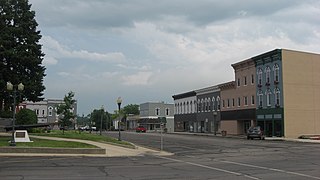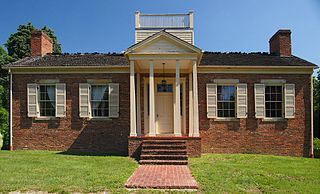
Greenville is a city in Bond County, Illinois, United States, 51 miles (82 km) east of St. Louis. The population as of the 2020 census was 7,083, up from 7,000 at the 2010 census. It is the county seat of Bond County.

Ottawa is a city in and the county seat of LaSalle County, Illinois, United States. It is located at the confluence of the navigable Fox River and Illinois River, the latter being a conduit for river barges and connects Lake Michigan at Chicago, to the Mississippi River, and North America's 25,000 mile river system. The population estimate was 18,668, as of 2022. It is the principal city of the Ottawa, IL Micropolitan Statistical Area.

Sullivan is a city in Moultrie County, Illinois, United States. The population was 4,413 at the time of the 2020 census. It is the county seat and largest city of Moultrie County. Sullivan is named after Sullivan's Island, South Carolina, where Fort Moultrie is located.

The Lincoln–Douglas debates were a series of seven debates in 1858 between Abraham Lincoln, the Republican Party candidate for the United States Senate from Illinois, and incumbent Senator Stephen Douglas, the Democratic Party candidate. Until the Seventeenth Amendment to the United States Constitution, which provides that senators shall be elected by the people of their states, was ratified in 1913, senators were elected by their respective state legislatures, so Lincoln and Douglas were trying to win the votes of the Illinois General Assembly for their respective parties.

Lincoln's New Salem State Historic Site is a reconstruction of the former village of New Salem in Menard County, Illinois, where Abraham Lincoln lived from 1831 to 1837. While in his twenties, the future U.S. President made his living in this village as a boatman, soldier in the Black Hawk War, general store owner, postmaster, surveyor, and rail splitter, and was first elected to the Illinois General Assembly.
The Illinois Historic Preservation Division, formerly Illinois Historic Preservation Agency, is a governmental agency of the U.S. state of Illinois, and is a division of the Illinois Department of Natural Resources. It is tasked with the duty of maintaining State-owned historic sites, and maximizing their educational and recreational value to visitors or on-line users. In addition, it manages the process for applications within the state for additions to the National Register of Historic Places.

The Old State Capitol State Historic Site, in Springfield, Illinois, is a former capitol building for the U.S. state of Illinois, and one of two preserved former Illinois capitol buildings. It was built in the Greek Revival style in 1837–1840, when Springfield became the capital city, and served as the state house from 1840 to 1876, when it was replaced by the current capitol. It is the site of candidacy announcements by Abraham Lincoln in 1858 and Barack Obama in 2007. It was designated a National Historic Landmark in 1961, primarily for its association with Lincoln and his political rival Stephen Douglas.

The Bryant Cottage State Historic Site is a simple four-room house located in Bement, Illinois in the U.S. state of Illinois. It was built in 1856 and is preserved by the Illinois Department of Natural Resources as an example of Piatt County, Illinois pioneer architecture and as a key historic site in the 1858 Lincoln-Douglas debates.

The Lincoln Log Cabin State Historic Site is an 86-acre (0.3 km2) history park located eight miles (13 km) south of Charleston, Illinois, U.S., near the town of Lerna. The centerpiece is a replica of the log cabin built and occupied by Thomas Lincoln, father of U.S. President Abraham Lincoln. Abraham Lincoln never lived here and only occasionally visited, but he provided financial help to the household and, after Thomas died in 1851, Abraham owned and maintained the farm for his stepmother, Sarah Bush Lincoln. The farmstead is operated by the Illinois Historic Preservation Agency.

Illinois Route 146 (IL 146) is an east–west state highway in the U.S. state of Illinois. It serves the extreme southern region of the state, commonly called Little Egypt or the Illinois Ozarks. IL 146 is 92.93 miles (149.56 km) long. An east–west highway, it serves Hardin County, Pope County, Johnson County, Union County, and Alexander County. These are some of the least-populated counties in Illinois. IL 146 serves two sections of the Shawnee National Forest.

The Metamora Courthouse State Historic Site is a historic American courthouse located in Metamora, Illinois, the former county seat of Woodford County. The courthouse was built in 1845 as the governmental center for Woodford County and as a circuit court for the former Illinois Eighth Circuit. The courthouse is best known for being one of only two surviving Illinois circuit courthouses where future U.S. President Abraham Lincoln practiced law.

The Judge John C. Flanagan Residence is a historic house in Peoria, Illinois, United States. It was added to the National Register of Historic Places in 1975 and is currently operated as a museum by the Peoria Historical Society.

Save America's Treasures is a United States federal government initiative to preserve and protect historic buildings, arts, and published works. It is a public–private partnership between the U.S. National Park Service and the National Trust for Historic Preservation. The National Endowment for the Arts, National Endowment for the Humanities, and Institute of Museum and Library Services are also partners in the work. In the early years of the program, Heritage Preservation and the National Park Foundation were also involved.

Washington Park Historic District, also known as Washington Square is a historic district in and around Washington Park in the city of Ottawa, Illinois, United States. Washington Park was the site of the first Lincoln-Douglas debates of 1858 and is surrounded by several historic structures. The park was platted in 1831 and the historic district was added to the United States National Register of Historic Places in 1973.

The Lincoln Oak was an oak tree in Bloomington, Illinois. Stephen A. Douglas and Abraham Lincoln both gave speeches at the tree during the 1850s. The original Lincoln Oak died in 1976.
The Civil War Trust's Civil War Discovery Trail is a heritage tourism program that links more than 600 U.S. Civil War sites in more than 30 states. The program is one of the White House Millennium Council's sixteen flagship National Millennium Trails. Sites on the trail include battlefields, museums, historic sites, forts and cemeteries.

Colonel William Jones House, also known as William Jones State Historic Site, is a historic house in Gentryville and the Lincoln State Park in Jackson Township, Spencer County, Indiana. It was listed on the National Register of Historic Places on May 12, 1975. William Jones (1803–1864) was a farmer, merchant, soldier, and politician.
The following outline is provided as an overview of and topical guide to Abraham Lincoln:

The Lincoln-Berry General Store was a general store that was co-owned by Abraham Lincoln. The store is one of the reconstructed 1830s buildings at Lincoln's New Salem, a state historic site. It was and is the only frame building in New Salem.

















